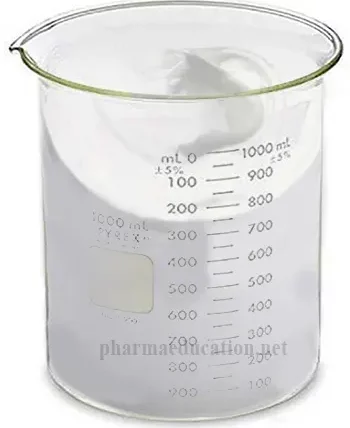“Cold cream is which type of emulsion” and “What is cold cream” both are common questions in pharmaceutics or a curious mind. Cold cream was first invented by Galen, a famous Greek physician-pharmacist in the Roman Empire (who practiced in Rome) of the 1st Century AD. It was originally described as the Latin word “refrigeran” meaning “making cold” because when applied, the water evaporates and creates a cooling sensation. According to emulsion types, cream are two types: Cold cream and Vanishing cream. Also read: Cold Cream: History, Formula, Method, Uses, Evaluation
Table of Contents
Definition of Cold Cream
Cold cream is a water-in-oil (W/O) emulsion, in the European Pharmacopoeia cold cream is described as Fatty Cream. When a water phase is dispersed in an oil phase, the emulsion is referred to as a water-in-oil (W/O) emulsion, and oil is referred to as the continuous phase. In cold cream, the major portion is the oil phase.
Simply the cold cream is an oil-based semisolid preparation. Cold cream is also known as Unguentum or Ceratum Refrigerans [1]. Generally, it contains mineral oil, beeswax, borax, and water [1]. Cream vs Ointment
Cold Creams are white to off-white, viscous, relatively soft, consistently spreadable, semisolid water in oil emulsion in which an aqueous phase (internal/disperse/discontinuous phase) is dispersed in an oil phase (external /continuous phase) and the proportion of fatty and oil phase predominates in cold cream. You may also read: Emulsifying agents or Emulsifiers or Emulgents
Cold cream is an oil-based semisolid preparation.
Cold cream is a water in oil (W/O) emulsion.
Why cold cream is called cold cream?
After the application of cold cream, you may feel a cooling effect. The name “cold cream” derives from the cooling feeling of the cream, when applied the water evaporates and creates a cooling sensation. Besides, in cold cream, the major portion is the oil phase thus cold cream is used especially in cold weather or winter season. On the other hand, vanishing cream is used for summer or hot weather because vanishing cream does not contain a large portion of the oil phase.
History of Cold Cream Preparation
Cold cream was first invented by Galen, a famous Greek physician-pharmacist in the Roman Empire (who practiced in Rome) of the 1st Century AD. The Galen formula of cold cream has changed but little in proportions or method of preparation throughout many centuries [2]. Poison vs Toxin, Side effect vs Toxic effect
The formula of Beeswax-Borax type Traditional Cold Cream
| Name of Raw materials | Quantity | Function |
| Mineral oil | 450.00 ml | Emollient, Solvent and vehicles of an oil phase |
| Beeswax | 160.00 g | Stiffening agent |
| Borax | 10.00 g | Emulsifying agent |
| Methyl parahydroxybenzoate | 1.20 g | Antimicrobial preservative |
| Propyl parahydroxybenzoate | 0.20 g | Antimicrobial preservative |
| Perfume | 3.00 g | Flavoring agent |
| Purified water | 375.60 ml | Vehicle and Solvent of an aqueous phase |

Evaluation of cold cream
The following several tests may perform to evaluate the quality of a cold cream
- Appearance/ Description
- Viscosity test: to predict spreadability
- Uniformity of Dosage Unit (for medicated cold cream)
- Impurities
- Microbiological Examination of cold cream: most important test for all types of semisolid preparations.
- Water content determination
- Assay (for medicated cold cream)
You may able to answer the following question shortly
Question: Cold cream is which type of emulsion?
Answer: Water in Oil (W/O) emulsion, in other words, Cold cream is an oil-based semisolid preparation.
References
- Remington, Joseph P., and Paul Beringer. Remington: The Science and Practice of Pharmacy. 21st edition. Philadelphia: Lippincott Williams & Wilkins; 2005.
- Susan C. Wivell, Clear cold cream cosmetic compositions, United States Patent. 1996. https://patents.google.com/patent/US5525344A/en
Conclusion: The simple answer to the question “Cold cream is which type of emulsion” is Water in Oil (W/O) emulsion. After reading the article “Cold Cream is Which Type of Emulsion” you may also read: Cold Cream: History, Formula, Method, Uses, Evaluation to know details about cold cream. Now, it’s clear that cold cream is which type of emulsion?